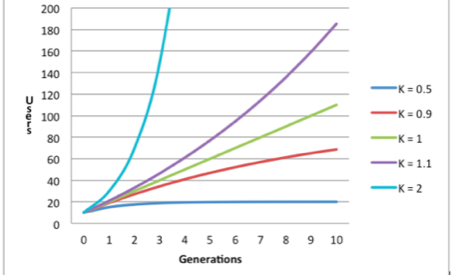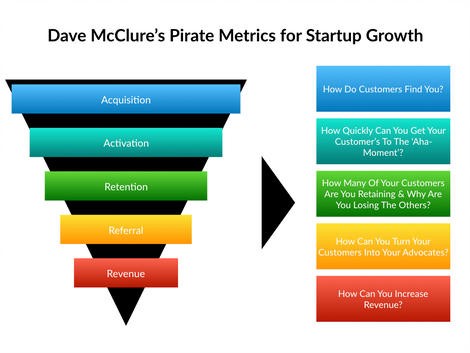 AARRR Metric Framework- Pirate Metrics for Startups
AARRR Metric Framework- Pirate Metrics for Startups
?Today, September 19th, is International Talk Like A Pirate Day, and thus, the perfect excuse to chat about one of the most important metric frameworks to live by as a startup marketer or Growth Hacker: The AARRR framework.
10 years ago? wow, that?s a long time ago.
10 years ago, Dave McClure, venture capitalist, angel investor, founder of startup accelerator 500 Startups and self proclaimed creep, introduced the world to a 5-step framework for growth. That framework was called AARRR, or also the Pirate Metrics.
Before we begin, more of a video person? Then watch this blog post below instead of reading it.
What is AARRR?
AARRR stands for Acquisition, Activation, Retention, Referral and Revenue and is pretty much the bee?s knees when it comes to understanding your customers, their journey and optimizing your funnel as well as setting some valuable and actionable metric goals for your startup.
Why AARRR?
AARRR is widely accepted as the five most important metrics for a startup to focus on. That is because these metrics effectively measure your company?s growth while at the same time being simple and actionable.
So without further ado, let?s begin.
- Acquisition ? ?Where Are Our Users / Customers Coming From??
Acquisition, the first A in the AARRR framework, describes how people find you and eventually turn in to customers.
In the dating world, acquisition would range from something like coincidentally meeting your future better half through a friend to wooing him/her into settling down with you (I?m sure your fantastic dancing skills played a part in this somewhere).
It?s important to view the acquisition part holistically.
That means not just looking at site visitors but also at how many and how those site visitors convert to customers. You want to track every step of your customer journey in the funnel not just look at the final conversion to a paying customer. Every micro-conversion along the way counts. To come back to the dating analogy, the first time you said ?I love you? counts too, not just the day you got married.
Let?s look at an example customer journey for a SaaS business:
Website visit -> email signup -> webinar participation -> call with sales team -> conversion to customer.
All those steps, before converting to a customer, count as micro-conversion and should be measured to a) understand your customer?s journey and b) optimize your customer?s journey. For SaaS and any other business that heavily relies on an active sales team it?s also important to distinguish between a lead and a qualified lead.
A lead is any visitor to your site who?s contact information you?ve captured in some way. That can be by email address or phone number. However, just because someone signs up for your emails doesn?t mean they are really looking to purchase anything from you (right now). Maybe you offered a free e-book or access to some exclusive content they wanted and that?s why they signed up. Maybe they just want to stay in the loop because they?re interested in your product but the timing is not quite right yet. A lead shouldn?t be viewed as someone who?s purchase intentions are necessarily high yet.
However, if a lead completes the next (or few next) micro-conversions in your customer journey, for example by watching a webinar on how to use your product or how your product solves a specific problem, you can consider them a qualified lead as they are actively engaged in vetting your product. That?s when the sales team should come in as the lead now is ?hot?.
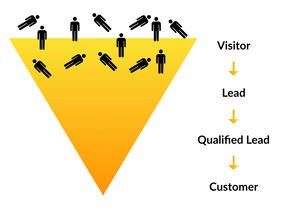 Lead Conversion Journey / Funnel
Lead Conversion Journey / Funnel
?I also want to take a second to talk about acquisition in the sense of getting eyeballs to your website. Many businesses, especially those that just start out, struggle with getting traffic to their website or app. I strongly recommend utilizing The Bullseye Framework as introduced by Gabriel Weinberg, founder of DuckDuckGo and author of Traction, at this stage.
The Bullseye Framework proposes that you look at all 19 channels that can possibly drive traffic to your website or product, but after brainstorming every channel, focus on one channel and test its success for your business in a small scale version. If you see success, scale that channel. If not, move on to testing another channel. It?s basically an acquisition channel testing version of the MVP process.
Weinberg states that for every business at different stages of growth one singular channel will be the main traffic driver. So find that channel and tweak every part of your communication until you see explosive (or something like it) growth. If every traction channel fails, there?s likely something wrong with your product/market fit.
Three fundamental questions you want to be asking yourself about your acquisition:
- What channel is driving the most traffic (#)?
- What channel is driving the most valuable traffic, in other words, performs best (%) in terms of customer conversion?
- What channel has the lowest customer acquisition cost ($), i.e. cost per customer converted?
I would like to end my recommendation to use The Bullseye Framework with the words of Peter Thiel, early Facebook investor and PayPal founder:
?It is very likely that one channel is optimal. Most businesses actually get zero distribution channels to work. Poor distribution ? not product ? is the number one cause of failure. If you can get even a single distribution channel to work, you have great business. If you try for several but don?t nail one, you?re finished. So it?s worth thinking really hard about finding the single best distribution channel.?
More on Gabriel Weinberg?s BullsEye Framework will come in a separate post. Till then enjoy this.
2. Activation ? ?How good is the user?s / customer?s first experience??
The way I like to use AARRR?s Acquisition and Activation part overlap a little. I will explain my reasoning for this below so bear with me.
Activation is about the first experience your customer has with your product. It is not enough to get people to download your app and/or even sign up, if they are going to stop using the app right after. That?s why it?s crucial to get your user to the ?Aha Moment?, which is the first time the user realizes the real value in your product, as quickly as possible so that he/she keeps coming back. The time between when the user signs up and when he says ?Holy cow, I love this?, that is activation in a nutshell.
The reason I like to include customer conversion under acquisition and differentiate it clearly from activation is because someone that signs up for your service is converted as a customer but they might not necessarily be using it. This has to be looked at differently for every type of business.
For an e-commerce business, activation is less important after conversion but more so after a micro-conversion, e.g. they sign up for your emails etc. You should look at how much content visitors are consuming and how they are consuming, for example on your website, and optimize their experience. Activation I would say is less important for e-commerce businesses compared to apps and SaaS businesses.
For an app, you should look at activation after people download / sign up for your app. Do they log-in once and never come back?
For a SaaS business, you want to look at the moment people start using your platform. You could think of the moment they sign up for your trial (or even full service) as the moment of acquisition. Every effort after that should be geared towards successfully activating your customer. SaaS businesses usually give extensive on-boarding support and provide an account manager / customer success manager (or whatever you want to call it) to walk you through the platform and show some standard solutions to get you started.
In other words, an activated customer is someone who keeps coming back to use your product. Facebook realized early in their growth that the ?Aha Moment? for a user occurred when they acquired 7 friends in 10 days, which is why they synced your email account with Facebook to suggest friends.
Twitter realized that once you followed 30 people you were more likely to come back so they suggest popular accounts when you sign up. Dropbox saw that users who uploaded at least one file were much more likely to use Dropbox again and so, you guessed it, they encourage you to upload a file during signup.
Again, to get users to the ?Aha Moment? as quickly as possible you want to make sure the on-boarding process is as seamless and enjoyable as possible. And then of course you want to test, test, test till you find your magic metric like Twitter, Dropbox and Facebook did and build your on-boarding process around it.
To turn your ?cold customers? into ones that actively use your product it?s a good idea to segment and start targeting these users with specific on-boarding emails. You should also specifically conduct customer interviews with these ?cold customers? to understand why they signed up but are not using your product.
3. Retention ? ?How many of your customers are you retaining and why are you losing the others??
If there was a church of marketing then I?d definitely be the preacher of retention. Customer retention is the first thing I look at when I am evaluating not just a company?s marketing efforts but their entire product success.
Retention means people regularly come back to use your product. For an e-commerce business that means someone not only buys from you once but multiple times. For an app, that means that users keep coming back and opening / using the app. For a SaaS business, that means that people who are subscribed to your software keep using it (often) and stay subscribed.
The opposite of customer retention would be customer churn. It is so incredibly important to measure your customer churn rate, I cannot emphasize it enough.
For one, your churn rate will tell you if you have achieved a good product/market fit. If a lot of people are dropping off your product after they start using it then clearly something might be wrong with either your product or your messaging. In the words of Bill Gates :?Your most unhappy customers are your greatest source of learning?.
Second, you want to make sure that your customer churn rate is lower than your customer acquisition rate. A lot lower. Because that?s the only way to achieve growth. You can think of it like a leaky bucket, it doesn?t matter how much water you pour into it (how many customers you acquire) the bucket won?t get fuller (your company won?t achieve growth) because it is leaking water at the bottom (your customers are churning).
Customer Acquisition Rate > Customer Churn Rate = Growth
Customer Churn Rate > Customer Acquisition Rate = Burning a lot of money
Third, according to Harvard Business Review it?s 5 to 25 times more expensive to acquire a new customer than to retain an existing one. It?s also easier to sell to someone who has purchased from you before as trust between you has already been established. Therefore, it is a lot cheaper and easier to cross-/up-sell or sell again to a customer you?ve already acquired before than to a ?stranger?.
So how can you increase customer retention?
The easiest way is to keep a nice share of mind of your customers by staying in touch. Email automation is a great method for this.
4. Referral ? ?How can you turn your customers into your advocates??
The absolute best way to drive growth is through referral. Why would you spend large sums of money on marketing to people?s deaf ears if you can just have people they trust rave about your product to them.
To really drive referrals you need to have a systematic process in place that incentivizes and generates them on a consistent basis.
Dropbox figured that out early on and their referral program was one of the main drivers of their growth.
 Dropbox Referral Program
Dropbox Referral Program
Hotmail essentially built its own referral program without the user even consciously knowing by including ?Get a free e-mail account with Hotmail? in every email that was sent from a Hotmail address.
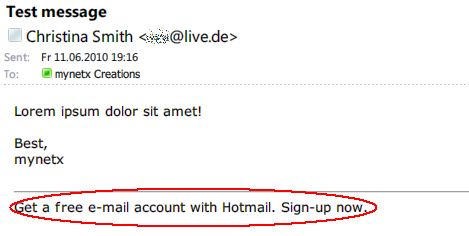 Hotmal Built-In Virality
Hotmal Built-In Virality
Two metrics you want to keep a close eye on for referrals are the Net Promoter Score (NPS), an index that ranges from -100 to 100 and measures how willing customers are to recommend your company?s products or services. It lets you know how satisfied and loyal your customers are to the brand.
 Net Promoter Score
Net Promoter Score
Another metric to pay attention to is the Viral Coefficient. The viral coefficient is the number of users a customer refers to you. A viral coefficient of two would mean that one customer on average refers two new customers to you. Your viral coefficient needs to be larger than one to have growth. The following graph shows you the exponential user growth you can have depending on your viral coefficient, i.e. the number of people one customer refers to you.
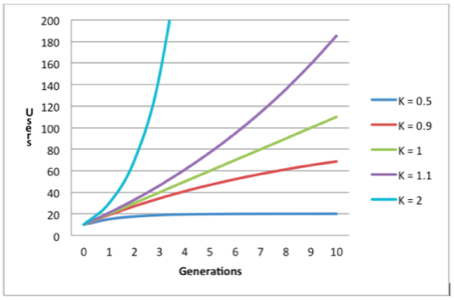 Viral Coefficient
Viral Coefficient
In the words of the president, it?s yuge! You can see that an incremental increase of K from 1 to 1.1 does wonders for your growth already and is really the driver behind virality. And isn?t that what every business wants: To go viral?
5. Revenue ? ?How can you increase revenue??
If you?ve optimized according to the four AARR metrics before, revenue should already be flowing in nicely. And no matter what anyone tells you, revenue and figuring out a monetization plan is important for any startup. Even Facebook and Instagram, companies that started out as pure social, non-monetary platforms, are only successful today because of the huge advertising business behind them.
So what?s the best way to increase revenue? By increasing your Customer Lifetime Value (CLV) and decreasing your Customer Acquisition Cost (CAC).
Your customer lifetime value is the amount of revenue you earn from a customer during their lifetime or rather the lifetime as a customer of your company.
Your customer acquisition cost (CAC) is the amount of money you spend on acquiring your customer. That includes cost for marketing, sales, meetings, fancy dinners or whatever it takes to get your customer to convert. A good ratio of CLV to CAC for growth is 3:1.
To reduce your customer acquisition cost you should optimize your sales funnel.
Summarizing, the AARRR framework is the simplest and most effective way to look at optimizing your business and measuring growth.
Every metric has deeper layers to it and I encourage you to look further into optimizing each.
___________
Get your own AARRR growth drivers & metrics checklist at www.melaniebalke.com &
read more about Growth Hacking & Marketing at www.melaniebalke.com/blog
